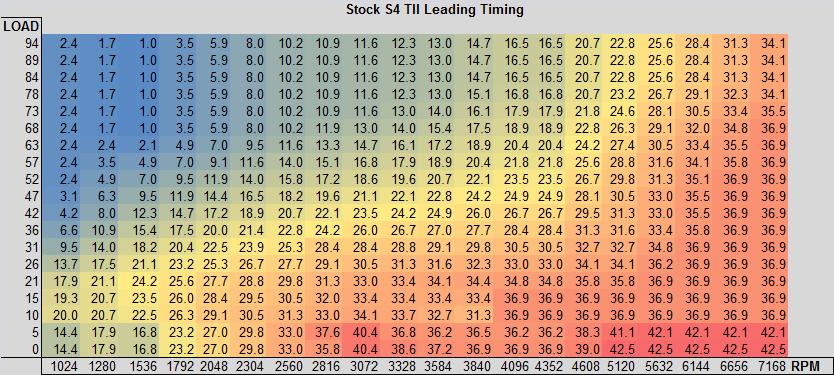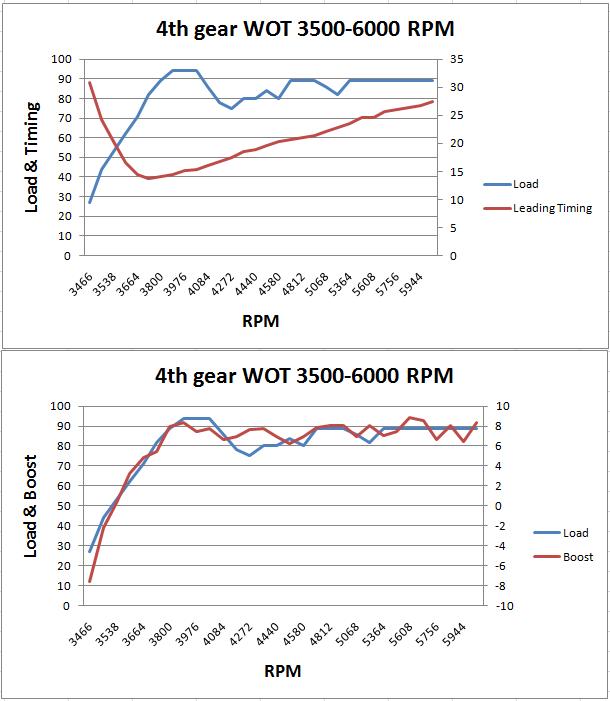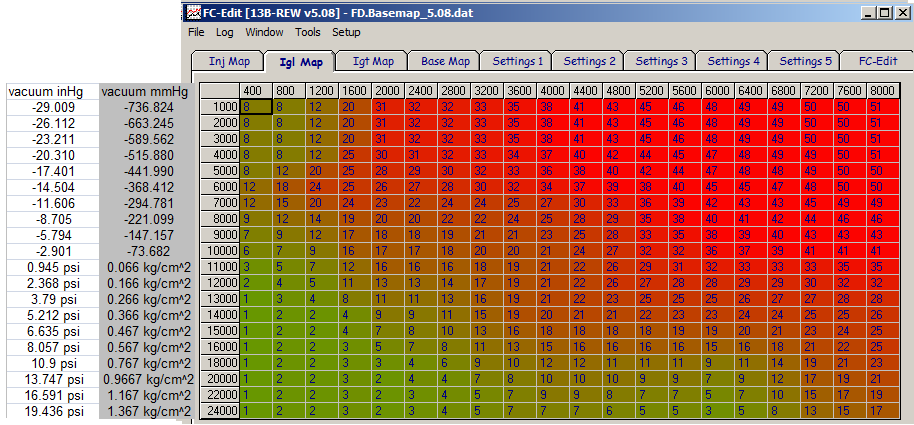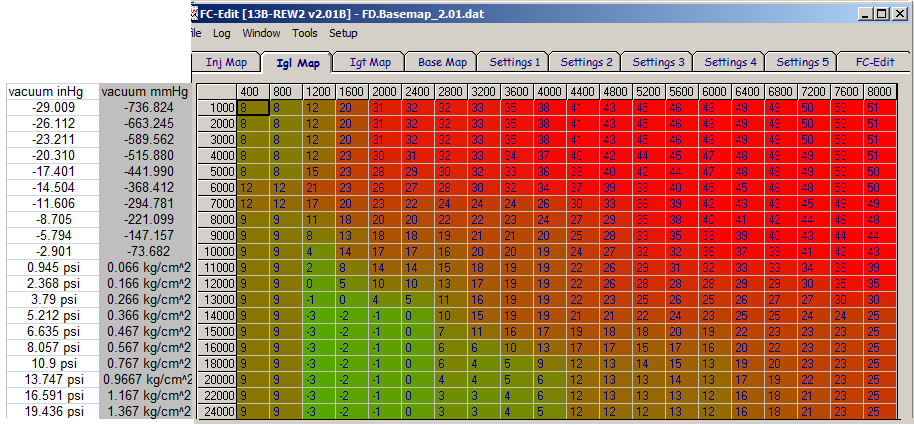How does 30* advance sound for 5psi at 6000rpm on a large street port sound
#1
Thread Starter
BadAss DoItYourselfer
iTrader: (9)
Joined: Jun 2008
Posts: 870
Likes: 4
From: Paradise
How does 30* advance sound for 5psi at 6000rpm on a large street port sound
Hello guys, I need a little advise on my low boost ignition timing. I am tuning the low boost area on my map. I have already got the fuel tuned, but just wanted to know how muchtiming you guys are usung at about 5psi. I am presently at about 17* at this level, but looking at other peoples maps, i am seeing between 28* - 33*.
Would you consider 30* with 10* split safe for 5psi?
Would you consider 30* with 10* split safe for 5psi?
#2
Joined: Dec 2001
Posts: 7,083
Likes: 117
From: Twin Cities, MN
17 degrees is too low, I would start @ 25 degrees at look at your knock readings..
#6
IMO, 30* is too much. Like J9 said, best NA performance is usually going to be less than 30*.
Usually, a safe rule of thumb is to start around 25* at 0 psi and ramp down to 13* at 15 psi. This should be a safe, conservative place to start with most street port engines. From there you start splitting hairs with the tuning to find what each engine/fuel/etc. combo likes.
Usually, a safe rule of thumb is to start around 25* at 0 psi and ramp down to 13* at 15 psi. This should be a safe, conservative place to start with most street port engines. From there you start splitting hairs with the tuning to find what each engine/fuel/etc. combo likes.
#7
What is the quality of the fuel? Be careful comparing to n/a timing maps. They have different rotors, they run on different fuel, completely different intake system, and they are used in different applications.
There's a lot of guesswork involved in tuning part-load timing like this given the resources available.
There's a lot of guesswork involved in tuning part-load timing like this given the resources available.
Trending Topics
#8
be aware also that on a haltech you are usually dealing in true crank degrees
reading 30 degrees on a micro map,, timed to the micro method is actually 25 BTDC in real crank degrees
as the manual recommends you use the 5 ATDC mark as datum zero
if you have instead set your micro up with new timing marks ( i remark the pulley for 10 and 25 BTDC )
and have used the static = 10 when you have done the timing lock ,, then you are in REAL crank degrees
you must be aware which method was used in the setup when you pinch random numbers from a micro map
else you are asking for shrapnel
easiest dumb map is to build from 25-26 real crank degrees at 0 psi @ 5000 rpm and remove 1 degree for every 1 psi
this is very conservative and you will find that under 10 psi you can sneak back in 2 or three degrees and offset the map a little
( 7000-9000 rpm past peak TQ you can sneak the timing up as far as 28 )
[ so you can end up with almost ludwigs recommends]
i prefer to build the timing maps this way,, sneaking up on the optimum ignition timing slowly
-- as often the base map is swapped between 8.5 and 9.0 and 9.4:1 rotors and you really shouldn't jump straight in if you have the higher comp pair
reading 30 degrees on a micro map,, timed to the micro method is actually 25 BTDC in real crank degrees
as the manual recommends you use the 5 ATDC mark as datum zero
if you have instead set your micro up with new timing marks ( i remark the pulley for 10 and 25 BTDC )
and have used the static = 10 when you have done the timing lock ,, then you are in REAL crank degrees
you must be aware which method was used in the setup when you pinch random numbers from a micro map
else you are asking for shrapnel
easiest dumb map is to build from 25-26 real crank degrees at 0 psi @ 5000 rpm and remove 1 degree for every 1 psi
this is very conservative and you will find that under 10 psi you can sneak back in 2 or three degrees and offset the map a little
( 7000-9000 rpm past peak TQ you can sneak the timing up as far as 28 )
[ so you can end up with almost ludwigs recommends]
i prefer to build the timing maps this way,, sneaking up on the optimum ignition timing slowly
-- as often the base map is swapped between 8.5 and 9.0 and 9.4:1 rotors and you really shouldn't jump straight in if you have the higher comp pair
#9
I know this is a turbo thread but, I don't understand how 30 degrees is too much on stock ports when the stock Rx8 runs 30 degrees NA with 10.0 compression rotors? The combustion pressures and temperatures are gonna be higher in the Renesis with that timing and that engine survives just fine at 30 degrees peak. 

#10
i don't think anyone's put up the stock s5 T2 timing maps but here are the timing maps for the S4 T2:



that map is for 8.5:1 rotors with 87 octane. Y axis is calculated load which is proportional to volume airflow divided by rpm
Somebody posted the s5 n/a maps somewhere... I gotta find them



that map is for 8.5:1 rotors with 87 octane. Y axis is calculated load which is proportional to volume airflow divided by rpm
Somebody posted the s5 n/a maps somewhere... I gotta find them
#12
Honestly, I don't know the formula used inside the ECU to calculate load. On a lot of systems it's pretty complicated because of correction for temperature and barometric pressure. I just know that it is proportional to airflow/rpm . Thus at any given rpm, if airflow increases load increases. The 2nd gens have a MAP sensor but it is not used as the primary means of load calculation. I do know that on a mostly stock engine it doesn't hit the top row. Here are the timing maps for the s5 nonturbo I was talking about:

That's with 9.7:1 compression and 87 octane, also with the variable intake runner length system (VDI). I don't think the load index is the same here. I think whoever made this map was literally counting from 0 to 18.

That's with 9.7:1 compression and 87 octane, also with the variable intake runner length system (VDI). I don't think the load index is the same here. I think whoever made this map was literally counting from 0 to 18.
#16
I've always stuck to 24 degrees max on 87. Guess I'm conservative hehe but good to know.
If you set the timing to 10 degrees with a 15 split you can zero the timing with the front trailing mark as if it were the leading.
thewird
thewird
#17
It's certainly interesting how a boosted turbo engine (S4 T2) runs more timing from the factory than a non turbo at the same octane rated at less horsepower and torque (S5 NA). Shows how much compression ratio, porting, and manifolds effect it.
The high amount of negative split for the s4 T2 is also strange considering it occurs at high rpm. I'm sure it has to do with emissions and the secondary air system. It may also be a driveability thing to reduce shock on deceleration.
The high amount of negative split for the s4 T2 is also strange considering it occurs at high rpm. I'm sure it has to do with emissions and the secondary air system. It may also be a driveability thing to reduce shock on deceleration.
#19
We talk about timing in the tuning group I have been running. For the benefit of you guys who are using different engine management, here are some of the default timing maps that come with the PFC:

That's from PFC version 5.08 which is what most PFC's come with.

That's from an early version of the PFC, 2.08

That's from the version for the FC series 5 Turbo.
Most of the trailing/split maps that came with the PFC are kinda ugly, they're not worth posting here

That's from PFC version 5.08 which is what most PFC's come with.

That's from an early version of the PFC, 2.08

That's from the version for the FC series 5 Turbo.
Most of the trailing/split maps that came with the PFC are kinda ugly, they're not worth posting here
#20
Moderator
iTrader: (3)
Joined: Mar 2001
Posts: 31,168
Likes: 2,812
From: https://www2.mazda.com/en/100th/
It's certainly interesting how a boosted turbo engine (S4 T2) runs more timing from the factory than a non turbo at the same octane rated at less horsepower and torque (S5 NA). Shows how much compression ratio, porting, and manifolds effect it.
The high amount of negative split for the s4 T2 is also strange considering it occurs at high rpm. I'm sure it has to do with emissions and the secondary air system. It may also be a driveability thing to reduce shock on deceleration.
The high amount of negative split for the s4 T2 is also strange considering it occurs at high rpm. I'm sure it has to do with emissions and the secondary air system. It may also be a driveability thing to reduce shock on deceleration.
the Rx8 does lots of negative split on decel too, leading just goes to -5BTDC, and the trailing kind of comes down with rpm, which is weird because it does this in fuel cut, where it shouldn't matter
#21
the Rx8 does lots of negative split on decel too, leading just goes to -5BTDC, and the trailing kind of comes down with rpm, which is weird because it does this in fuel cut, where it shouldn't matter
Thread
Thread Starter
Forum
Replies
Last Post





